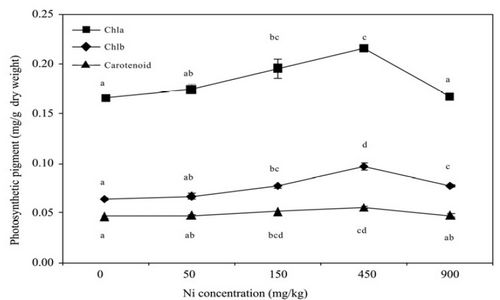Nickel effects on growth and antioxidative enzymes activities in desert plant Zygophyllum xanthoxylon (Bunge) Maxim
Updatetime:2011-02-11From:
【Enlarge】【Reduce】
One-month old Zygophyllum xanthoxylon seedlings were grown under five different Ni concentrations (0, 50, 150, 450 and 900mg/kg). Growth parameters, tissues Ni accumulation, soluble protein content, photosynthetic pigment content, lipid peroxidation,antioxidative enzyme activities, and proline content were studied after one month of Ni exposure. The significant reduction in fresh biomass in the shoot and roots was detected at high Ni concentrations (≥450 mg/kg), whereas dry biomass was not significantly affected in both organs by any of the Ni doses tested. The Ni contents in the shoots and roots increased in a dose-dependent manner, and Ni contents in roots were higher than that in shoots at all treatments. The high Ni doses elevated soluble protein contents in leaves and roots. No visible symptoms of chlorosis were observed in leaves of plants grown in presence of Ni. Malondialdehyde (MDA) contents significantly increased in leaves and roots at high Ni treatments (≥450 mg/kg), indicating that Ni induces oxidative stress. Enzyme activities might play a central role in cellular protection against the Ni induced oxidative stress. Proline contents proportionally increased with the elevated Ni concentrations. Zygophyllum xanthoxylon revealed moderate Ni tolerance under tested culture conditions, and could be used as tools for revegetation for erosion control in moderate Ni contaminated sites.
|
Effects of different Ni concentrations on photosynthetic pigments content in leaves of Z. xanthoxylon. Results are means±SE of three independent replicates. Different letters in the same photosynthetic pigment are significant at P<0.05 according to Fisher’s LSD test.(Picture/Sciences in Cold and Arid Regions) |
Appendix





